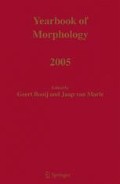I thank Giorgio Banti, Dagmar Haumann, Johannes Helmbrecht, Nils Jahn, Yoko Nishina, Su-Rin Ryu and two anonymous reviewers of the Yearbook of Morphology for helpful comments on the first draft and for a couple of examples.
Access this chapter
Tax calculation will be finalised at checkout
Purchases are for personal use only
Preview
Unable to display preview. Download preview PDF.
References
Bloomer, Robert K. (1996). Die pleonastischen Zusammensetzungen der deutschen Gegenwartssprache. American Journal of Germanic Linguistics and Literatures 8, 69–90.
Booij, Geert (2005a). The Grammar of Words. An Introduction to Linguistic Morphology. Oxford: Oxford University Press.
Booij, Geert (2005b). Paradigmatic morphology. In Bernard Tranel and Georgette Dal (eds.), Hommage a Danielle Corbin. Amsterdam: Benjamins.
Cennamo, Michela (1999). Late Latin pleonastic reflexives and the unaccusative hypothesis. Transactions of the Philological Society 97(1), 103–150.
Chao, Yuen Ren (1968). A Grammar of Spoken Chinese. Berkeley: University of California Press.
Coseriu, Eugenio (1958). Sincronía, diacronía e historia. El problema del cambio lingüístico. Montevideo: Universidad de la República de Uruguay, Faculdad de Humanidades y Ciencias (Repr.: Madrid: Gredos, 1973.)
Dressler, Wolfgang U. (2004). Hypercharacterisation and productivity in inflectional morphology. In Thomas Krisch, Thomas Lindner and Ulrich Müller (eds.), Analecta homini universali dicata. Arbeiten zur Indogermanistik, Linguistik, Philologie, Politik, Musik und Dichtung. Festschrift für Oswald Panagl zum 65. Geburtstag. 2 Bde. Stuttgart: H.-D. Heinz (Stuttgarter Arbeiten zur Germanistik, 421); 2, 515–524.
Dressler, Wolfgang U., Katarzyna Dziubalska-Kolaczyk, and Rossella Spina (2001). Sources of markedness in language structures. Folia Linguistica Historica 22, 103–135.
Fleischer, Wolfgang (1971). Wortbildung der deutschen Gegenwartssprache. Tübingen: M. Niemeyer (2. unveränd. Aufl.; 1.: Leipzig: VEB Verlag Enzyklopädie, 1969).
Haiman, John (1985). Natural Syntax. Iconicity and Erosion. Cambridge: Cambridge University Press.
Haspelmath, Martin (1993). The diachronic externalization of inflection. Linguistics 31, 279–309.
Jakobson, Roman (1960). Closing statement: Linguistics and poetics. In Thomas A. Sebeok (ed.), Style in Language. Cambridge, MA: MIT Press; New York: Wiley, 350–377.
Kaunisto, Mark (1999). Electric/electrical and classic/classical: Variation between the suffixes -ic and -ical. English Studies 80, 343–370.
Knobloch, Clemens (2002). Zwischen Satz-Nominalisierung und Nennderivation: -unq-Nomina in Deutschen. Sprachwissenschaft 27, 333–362.
Koefoed, Geert and Jaap van Marle (2004). Fundamental concepts [of morphological change]. In Geert Booij, Christian Lehmann, Joachim Mugdan and Stavros Skopeteas (eds.), Morphologie. Ein internationales Handbuch zur Flexion und Wortbildung. 2. Halbband. Berlin: W. de Gruyter (HandbÜcher zÜr Sprach-und Kommunikationswissenschaft, 17.2); 1574–1589.
Lausberg, Heinrich (1990). Handbuch der literarischen Rhetorik. Eine Grundlegung der Literaturwissenschaft. Stuttgart: F. Steiner (3rd edn.=repr. of the 2nd., enl. edn. 1973).
Lehmann, Christian (1982). Universal and typological aspects of agreement. In Hansjakob Seiler and Franz Josef Stachowiak (eds.), Apprehension. Das sprachliche Erfassen von Gegenständen. Teil II: Die Techniken und ihr Zusammenhang in den Einzelsprachen. Tübingen: G. Narr (LUS, 1, II); 201–267.
Lehmann, Christian (2002). Thoughts on Grammaticalization. Erfurt: Seminar fÜr Sprachwissenschaft der Universität (ASSidUE, 9) (2. revised edition).
Löfstedt, Einar (1933). Wortform, Wortumfang und Verwandtes. In Einar Löfstedt, Syntactica. Studien und Beiträge zur historischen Syntax des Lateins. Zweiter Teil: Syntaktischstilistische Gesichtspunkte und Probleme. Lund etc.: Gleerup (Acta Reg. Societatis Humaniorum Litterarum Lundensis, X:2); 35–62.
Malkiel, Yakov (1957f). Diachronic hypercharacterization in Romance. Archivum linguisticum 9, 79–113; 10, 1–36.
Marantz, Alec and Caroline Wiltshire (2000). Reduplication. In Geert Booij, Christian Lehmann and Joachim Mugdan (eds.), Morphologie. Ein internationales Handbuch zur Flexion und Wortbildung. 1. Halbband. Berlin: W. de Gruyter (HandbÜcher zÜr Sprach-und Kommunikationswissenschaft, 17.1); 557–567.
Ortmann, Albert (1999). Affix repetition and non-redundancy in inflectional morphology. Zeitschrift für Sprachwissenschaft 18, 76–120.
Paul, Hermann (1920). Prinzipien der Sprachgeschichte. Tübingen: M. Niemeyer (5th edn.).
Plag, Ingo (2005). Syntactic category information and the semantics of derivational morphological rules. Folia Linguistica 38, 195–225.
Plank, Frans (1981). Morphologische (Ir-) Regularitäten. Aspekte der Wortstrukturtheorie. Tübingen: G. Narr (Studien zur deutschen Grammatik, 13).
Rusakova, Marina V. (2004). Russian diminutive/hypocoristic adjectives: Between inflection and derivation. 11th International Morphology Meeting, Vienna, 14–17 February 2004.
Sherer, Tim D. (1994). Prosodic phonotactics, PhD dissertation. Amherst: University of Massachusetts.
Stolz, Thomas (2004). Pleonastic morphology dies hard. Evidence from Lithuanian and sundry languages. 11th International Morphology Meeting, Vienna, 14–17 February 2004.
Author information
Authors and Affiliations
Editor information
Editors and Affiliations
Rights and permissions
Copyright information
© 2005 Springer
About this chapter
Cite this chapter
Lehmann, C. (2005). Pleonasm and hypercharacterisation. In: Booij, G., Van Marle, J. (eds) Yearbook of Morphology 2005. Yearbook of Morphology. Springer, Dordrecht . https://doi.org/10.1007/1-4020-4066-0_5
Download citation
DOI: https://doi.org/10.1007/1-4020-4066-0_5
Publisher Name: Springer, Dordrecht
Print ISBN: 978-1-4020-4065-8
Online ISBN: 978-1-4020-4066-5
eBook Packages: Humanities, Social Sciences and LawSocial Sciences (R0)

